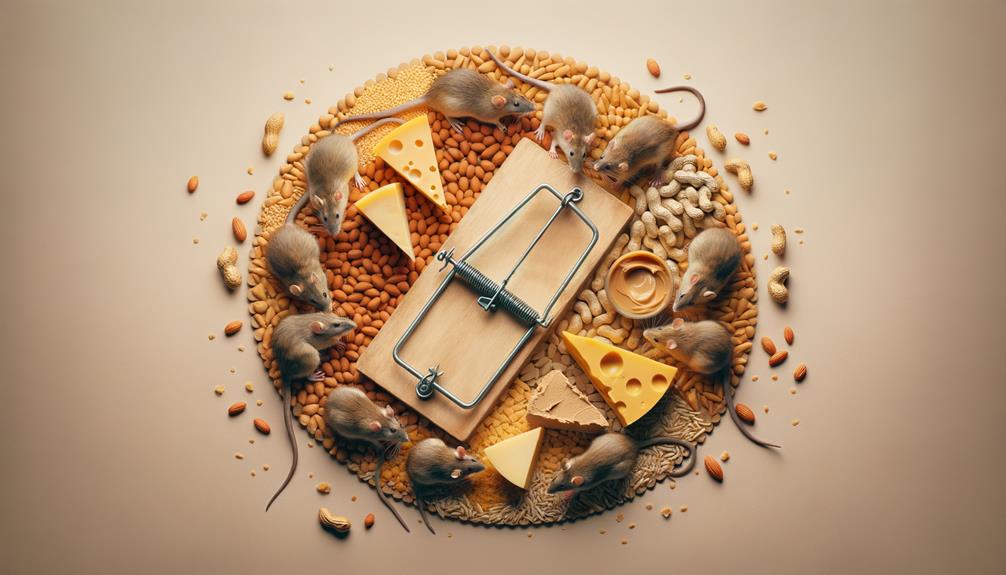Did you know that nearly 20% of the world’s food supply is consumed or contaminated by rodents? When you’re facing a rat problem, choosing the right rat bait can make all the difference.
Whether it’s the high efficacy of professional-grade poisons like Formula B Rat Killer or natural alternatives that might appeal for safety and environmental reasons, the best bait doesn’t just attract rats—it ensures they don’t come back.
But with so many options out there, how do you decide which is truly the best for your situation? Let’s explore some key factors that could tip the scales in your favour.
Key Takeaways
- Natural baits like peanut butter and meats are highly effective due to their strong scent and protein content.
- Homemade and commercial baits, such as Pest Expert products, offer versatility in trapping success.
- Avoid using cheese as bait and ensure baits are weather-appropriate and not overflowing.
- Safety measures include using bait with bittering agents and secure storage to prevent accidental ingestion by non-targets.
Optimal Natural Rat Bait

When selecting the most effective rat bait, consider incorporating natural options like peanut butter and chocolate, which are proven to attract rats due to their strong scents and appealing tastes. These ingredients, widely available in your pantry, serve as the basis for homemade concoctions that offer unique alternatives to standard baits. By harnessing the allure of peanut butter’s rich aroma and the tempting sweetness of chocolate, you’re employing a strategy that speaks directly to the rodents’ preferences.
Expanding your arsenal with DIY bait recipes allows you to explore unconventional options. Nut butter, such as almond or hazelnut, present a versatile substitute, enriching your bait selection with their distinctive fragrances and flavours. Moreover, incorporating meat-based baits like bacon or sausage capitalizes on their protein content and potent smell, significantly enhancing your bait’s attractiveness.
Utilizing a combination of these natural baits not only broadens your approach but also increases your chances of successfully attracting and trapping rats. This method, rooted in understanding and leveraging the dietary preferences of rats, underscores a comprehensive and effective strategy in rat control.
Effective Commercial Lures
While natural baits offer a DIY approach to rat control, exploring commercially available lures presents a powerful alternative for those seeking maximum effectiveness. Pest Expert’s range, featuring rat poison blocks and grain bait with Brodifacoum, stands out for its strength and efficiency. Unlike some DIY alternatives and homemade recipes, these wax-free blocks are designed to be more palatable, ensuring rats consume more bait for effective control.
The Formula B Rat Killer Poison from Pest Expert simplifies the process, eliminating the need for rotation with other rodenticides and promising consistent results. This aspect is crucial for those committed to maintaining a rodent-free environment without the constant search for new solutions. Furthermore, the inclusion of lockable bait boxes and trays in their rat poison kits addresses the crucial aspects of bait station selection and placement tips, ensuring safe and strategic positioning to maximize effectiveness.
Priced competitively, Pest Expert’s products cater to various infestation levels, from 60g sachets to extensive 6kg kits, demonstrating their commitment to providing accessible, professional-grade solutions for effective rodent control. This positions Pest Expert as a go-to resource for those transitioning from less effective DIY methods to more reliable commercial lures.
Common Baiting Mistakes

Despite the availability of various commercial lures, many individuals inadvertently undermine their rat control efforts by making common baiting mistakes. Avoiding cheese as bait is a critical first step; its strong odor doesn’t necessarily entice all rat species. You’re aiming for success, not just setting a scene from a cartoon.
Choosing baits that maintain weather stability is equally important. Baits that degrade or lose their appeal in adverse weather conditions can severely limit your trapping success. This is about precision, ensuring your efforts remain effective regardless of the weather.
Another common pitfall is overloading traps with bait. This can allow rats to nibble away without ever triggering the trap. It’s a delicate balance; you want to lure them in, not provide a free meal.
Monitoring consumption and adjusting your strategy, including trap placement, is crucial. If you’re not keeping an eye on what’s being eaten and what’s not, you’re missing out on valuable insights. Rats are clever; they learn and adapt. If you notice bait consumption declining, it’s time to switch up your offerings.
Safety Considerations
Ensuring the safety of non-target species and humans is paramount when deploying rat bait. It’s crucial to adopt precautionary measures that safeguard everyone’s well-being while targeting those pesky rodents.
By selecting rat bait with added bittering agents, you’re taking a significant step towards preventing accidental ingestion by either humans or pets. These agents act as a deterrent, making the bait less appealing to those who aren’t the intended targets.
Storage solutions play a vital role in maintaining safety. Always secure your rat bait in tamper-resistant bait stations. These specialized containers are designed to prevent access by children, pets, and other non-target animals, reducing the risk of unintended exposure. Moreover, placing the bait in areas out of reach, such as behind appliances or in ceiling voids, minimizes the chances of pets coming into contact with these potentially harmful substances.
Regular inspection of bait stations is essential. You’ll want to check for any signs of tampering or damage, ensuring they continue to provide a safe barrier against unintended access. Additionally, adhering to the manufacturer’s guidelines for the proper disposal of unused rat bait is critical. This step helps prevent environmental contamination, underscoring your commitment to safety and responsible pest management.
Innovative Bait Strategies

To effectively combat rodent problems, consider leveraging innovative bait strategies that utilize familiar foods like chocolate, nut butter, and peanut butter to trap rats more efficiently. These sweet treats not only attract rats with their enticing aromas but also offer a high success rate in trapping. But don’t stop there; integrating savoury solutions into your arsenal can significantly enhance your baiting approach. Incorporating pet food or compost into your strategies can attract rats with familiar scents and textures, making the bait irresistible.
Customizing bait options with unique ingredients creates an attractive aroma that entices rats to feed. By tailoring baits to specific rat preferences, you’re not just setting a trap; you’re offering a delicacy that’s hard to resist. This customization increases the effectiveness of your trapping efforts and maximizes success.
Don’t be afraid to experiment with different bait combinations. Observing rat behaviour in response to various baits will help you optimize your strategies for successful outcomes. Remember, the key to innovative baiting lies in understanding and appealing to rat preferences. By doing so, you’ll find yourself part of a community of savvy individuals who’ve mastered the art of effective rodent control.
Conclusion
In your quest to conquer rat infestations, you’ve learned that the best baits blend nature’s allure with human innovation. While natural baits entice, commercial lures like Pest Expert’s potent formulations ensure victory.
Yet, effectiveness isn’t just about choice; it’s about application. Avoid common pitfalls and prioritize safety, integrating traditional wisdom with cutting-edge strategies. This balanced approach isn’t merely about eradicating pests—it’s a testament to harmonizing human ingenuity with the natural order, safeguarding both health and habitat.
You may also enjoy reading this article
Was This Article Helpful?
- Please provide feedback and comments to help us improve our content.
- Share your experiences and any additional tips you have for dealing with pests.
Share this Post



